Improved Variational Mode Decomposition in Pipeline Leakage Detection at the Oil Gas Chemical Terminals Based on Distributed Optical Fiber Acoustic Sensing System
Abstract
1. Introduction
- To combine particle swarm optimization with VMD and propose an improved particle swarm optimization (IPSO) algorithm for the first time, which optimizes the decomposition mode number K and penalty factor α.
- To employ a denoising method combining VMD and fuzzy dispersion entropy is first proposed to determine the effective IMFs.
- To present a new threshold setting method, which can avoid the drawbacks of traditional methods that rely on instantaneous values to determine leaks.
2. Methodology
2.1. Brief Description of VMD
- For each mode function , , analyze the signal using the Hilbert transform [24] and obtain its unilateral spectrum [18].where is the impact function and represents the K IMFs, which are components of the signal being decomposed. ∗ denotes convolution, and it also represents convolution in the following formula.
- For each mode function , mix the exponents of its center frequency , which can modulate the spectrum of each mode to the corresponding fundamental frequency band [25].where is the K center frequency.
- Using the Gaussian smoothing method to demodulate the signal, estimate the bandwidth of each modal signal, i.e., the gradient squared norm, and then solve the variational problem with constraints. The expression for the constrained variational problem is [26]:where is the derivative of the function over time.
- By introducing the Lagrangian multiplier and the second penalty factor α, the constrained variational problem can be transformed into an unconstrained variational problem [27], as follows:where are commonly used to enclose the objective function to indicate that it is part of the variational problem pair that needs to be solved.
- Use the alternating direction multiplier method to solve the variational problem mentioned above, and find the “saddle point” of the extended Lagrangian expression through alternating updates , , and . , which are the remainders of the Wiener filter. Formula (5) is converted to nonnegative frequency interval integral form to obtain the update method of ; the solution of the quadratic optimization problem was solved in the literature [18]:
- Similarly, the update method of the center frequency can be obtained [18]:
2.2. Particle Swarm Optimization Algorithm
2.3. Selection of Effective IMFs
- Firstly, utilizing the normal distribution function:Map to , where . Among them, and represent the standard deviation (SD) and mean value of the time series , respectively.
- Furthermore, through linear transformation:Map to , c indicates the number of classes.
- Calculate the dispersion pattern , where . The dispersion pattern is also composed of -digit numbers, each number has different values, so there is a total of corresponding dispersion patterns.
- The probability of every dispersion pattern in the time series is calculated as follows [32]:where represents the sum of membership degrees of the dispersion patterns attributed to all series, is divided by the total number of embedded signals with embedding dimension , and is the degree of membership of .
- Finally, FuzzDispEn, with the embedding dimension and number of class c, is calculated as follows:
3. Leakage Detection Method Based on IPSO–VMD
3.1. Signal Denoising Method Based on IPSO–VMD
- Preprocessing of signal collected by DAS system using wavelet transform.
- Set the range of VMD parameters, where the value of K is set to [2–10], and α is set to [0–5000], initialize the parameters of the particle swarm optimization algorithm, where = 2, = 2, = 2, = 0.7, sizepop = 50, and determine the fitness function during the optimization process [28]:Among them, is the normalized form of , is the envelope signal obtained by Hilbert demodulation of signal .
- Initialize particle swarm to optimize parameter combinations [K, α] as the position of the particle swarm and randomly generate the initial position and movement speed of particles.
- Run VMD processing at different particle positions and calculate the fitness value for each particle.
- Compare the fitness function values at different positions to obtain min, thereby updating individual local extremum and population global extremum. Update particle velocity and position with the Equations (8) and (9).
- Repeat steps (3) to (4) for the maximum number of iterations and output the best fitness value and the best particle position.
- Optimize [K, α] value input VMD algorithm for signal decomposition so that K IMF components can be obtained.
- Use FuzzDispEn [33] to calculate the similarity between the variance of the input signal and each IMF component, defined as follows:
- Calculate the maximum slope D of FuzzDispEn for two adjacent IMFs:
- The two adjacent modal components with the maximum increment of D are used as the turning points for selecting effective components, and the modal components with the maximum mutation of D and after are considered as noise signals. The final reconstructed signal s is obtained by adding up the effective modes.
3.2. Leakage Threshold Setting
4. Experimental Results and Discussion
4.1. Experimental Instrumentations and Environment
4.1.1. Gas Pipeline System
4.1.2. Fiber Optic Sensing System
4.2. Results and Analysis Based on IPSO–VMD
4.3. Leakage Localization
5. Conclusions
Author Contributions
Funding
Institutional Review Board Statement
Informed Consent Statement
Data Availability Statement
Conflicts of Interest
Abbreviations
| VMD | Variational mode decomposition |
| DAS | Distributed optical fiber acoustic sensing system |
| EMD | Empirical mode decomposition |
| SSA | Sparrow search algorithm |
| PSO | Particle swarm optimization |
| IMFs | Intrinsic mode functions |
| IPSO | Improved particle swarm optimization |
| Gbest | Previous best position |
| Zbest | Best fitness value |
| FuzzDispEn | Fuzzy dispersion entropy |
| DE | Dispersion entropy |
| MSD | Moving standard deviation |
| MSE | Mean square error |
| SNR | Signal-to-noise ratio |
| AI | Artificial intelligence |
References
- Latif, J.; Shakir, M.Z.; Edwards, N.; Jaszczykowski, M.; Ramzan, N.; Edwards, V. Review on condition monitoring techniques for water pipelines. Measurement 2022, 193, 110895. [Google Scholar] [CrossRef]
- Manogharan, P.; Rivière, J.; Shokouhi, P. Toward In-situ characterization of additively manufactured parts using nonlinear resonance ultrasonic spectroscopy. Res. Nondestruct. Eval. 2022, 33, 243–266. [Google Scholar] [CrossRef]
- Li, G.; Zeng, K.; Zhou, B.; Yang, W.; Lin, X.; Wang, F.; Chen, Y.; Ji, X.; Zheng, D.; Mao, B.-M. Vibration monitoring for the West-East Gas Pipeline Project of China by phase optical time domain reflectometry (phase-OTDR). Instrum. Sci. Technol. 2020, 49, 65–80. [Google Scholar] [CrossRef]
- Tomassi, A.; de Franco, R.; Trippetta, F. High-resolution synthetic seismic modelling: Elucidating facies heterogeneity in carbonate ramp systems. Pet. Geosci. 2025, 31, petgeo2024-047. [Google Scholar] [CrossRef]
- Philibert, M.; Yao, K.; Gresil, M.; Soutis, C. Lamb waves-based technologies for structural health monitoring of composite structures for aircraft applications. Eur. J. Mater. 2022, 2, 436–474. [Google Scholar] [CrossRef]
- Butterfield, J.D.; Krynkin, A.; Collins, R.P.; Beck, S.B.M. Experimental investigation into vibro-acoustic emission signal processing techniques to quantify leak flow rate in plastic water distribution pipes. Appl. Acoust. 2017, 119, 146–155. [Google Scholar] [CrossRef]
- Wang, J.; Ren, L.; Jia, Z.; Jiang, T.; Wang, G.-X. A novel pipeline leak detection and localization method based on the FBG pipe-fixture sensor array and compressed sensing theory. Mech. Syst. Signal Process. 2022, 169, 108669. [Google Scholar] [CrossRef]
- Siddique, M.F.; Ahmad, Z.; Kim, J.-M. Pipeline leak diagnosis based on leak-augmented scalograms and deep learning. Eng. Appl. Comput. Fluid Mech. 2023, 17, 2225577. [Google Scholar] [CrossRef]
- Ahmad, Z.; Nguyen, T.-K.; Kim, J.-M. Leak detection and size identification in fluid pipelines using a novel vulnerability index and 1-D convolutional neural network. Eng. Appl. Comput. Fluid Mech. 2023, 17, 2165159. [Google Scholar] [CrossRef]
- Xiao, R.; Hu, Q.; Li, J. Experimental investigation on vibro-acoustic techniques to detect and locate leakages in gas pipelines. Meas. Sci. Technol. 2021, 32, 114004. [Google Scholar] [CrossRef]
- Tu, Q.C.; Wei, B.; Zhang, Z.Y.; Shi, X.B. OTDR-type Distributed Optical Fiber Sensors and Application of Oil and Gas Pipelines Online Monitoring. Pipeline Technol. Equip. 2015, 3, 28–31. [Google Scholar]
- Tong, J.K.; Jin, B.Q.; Wang, D.; Wang, Y.; Hui, Y.; Bai, L. Distributed Optical Fiber Temperature Measurement System for Pipeline Safety Monitoring Based on R-OTDR. Chin. J. Sens. Actuators 2018, 31, 158–162. [Google Scholar] [CrossRef]
- Muanenda, Y. Recent advances in distributed acoustic sensing based on phase-sensitive optical time domain reflectometry. J. Sens. 2018, 2018, 3897873. [Google Scholar] [CrossRef]
- Stajanca, P.; Chruscicki, S.; Homann, T.; Seifert, S.; Schmidt, D.; Habib, A. Detection of leak-induced pipeline vibrations using fiber—Optic distributed acoustic sensing. Sensors 2018, 18, 2841. [Google Scholar] [CrossRef] [PubMed]
- Wu, H.; Duan, H.F.; Lai, W.W.; Zhu, K.; Cheng, X.; Yin, H.; Zhou, B.; Lai, C.C.; Lu, C.; Ding, X. Leveraging optical communication fiber and AI for distributed water pipe leak detection. IEEE Commun. Mag. 2023, 62, 126–132. [Google Scholar] [CrossRef]
- Guo, C.; Wen, Y.; Li, P.; Wen, J. Adaptive noise cancellation based on EMD in water-supply pipeline leak detection. Measurement 2016, 79, 188–197. [Google Scholar] [CrossRef]
- Li, Y.; Li, Y.; Chen, X.; Yu, J. Denoising and feature extraction algorithms using NPE combined with VMD and their applications in ship-radiated noise. Symmetry 2017, 9, 256. [Google Scholar] [CrossRef]
- Dragomiretskiy, K.; Zosso, D. Variational mode decomposition. IEEE Trans. Signal Process. 2014, 62, 531–544. [Google Scholar] [CrossRef]
- Lu, J.; Yue, J.; Zhu, L.; Li, G. Variational mode decomposition denoising combined with improved Bhattacharyya distance. Measurement 2019, 151, 107283. [Google Scholar] [CrossRef]
- Peng, L.; Hu, Y.; Zhang, J.; Lin, J. Pipeline leak location method based on SSA-VMD with generalized quadratic cross-correlation. Meas. Sci. Technol. 2024, 35, 116105. [Google Scholar] [CrossRef]
- Du, H.; Wang, J.; Qian, W.; Zhang, X. An Improved Sparrow Search Algorithm for the Optimization of Variational Modal Decomposition Parameters. Appl. Sci. 2024, 14, 2174. [Google Scholar] [CrossRef]
- Jiang, Z.; Guo, G.; Liu, B. Application research of negative pressure wave signal denoising method based on VMD. Appl. Sci. 2023, 13, 4156. [Google Scholar] [CrossRef]
- Diao, X.; Jiang, J.; Shen, G.; Chi, Z.; Wang, Z.; Ni, L.; Mebarki, A.; Bian, H.; Hao, Y. An improved variational mode decomposition method based on particle swarm optimization for leak detection of liquid pipelines. Mech. Syst. Signal Process. 2020, 143, 106787. [Google Scholar] [CrossRef]
- Hahn, S.L. Hilbert Transforms in Signal Processing; Artech House Publish: Boston, MA, USA, 1996. [Google Scholar]
- Duan, J.Y.; Duan, T.Y.; Liu, H.; Jiang, T.F.; Jin, X.X. Application of variational mode decomposition in denoising of microseismic signals. Petrochem. Technol. 2015, 22, 217. [Google Scholar]
- Xiao, Q.; Li, J.; Sun, J.; Feng, H.; Jin, S. Natural-gas pipeline leak location using variational mode decomposition analysis and cross-time–frequency spectrum. Measurement 2018, 124, 163–172. [Google Scholar] [CrossRef]
- Huang, W.; Jiang, Y.; Sun, H.; Wang, W. Automatic quantitative diagnosis for rolling bearing compound faults via adapted dictionary free orthogonal matching pursuit. Measurement 2020, 154, 107474. [Google Scholar] [CrossRef]
- Tang, G.; Wang, X. Parameter Optimization Variational Mode Decomposition Method in Rolling Application of early fault diagnosis in dynamic bearings. Xi’an Jiaotong Univ. J. 2015, 49, 73–81. [Google Scholar]
- Nguyen, V.D.; Tran, Q.D.; Vu, Q.T.; Duong, V.T.; Nguyen, H.H.; Hoang, T.T.; Nguyen, T.T. Force Optimization of Elongated Undulating Fin Robot Using Improved PSO-Based CPG. Comput. Intell. Neurosci. 2022, 2022, 2763865. [Google Scholar] [CrossRef]
- Del Valle, Y.; Venayagamoorthy, G.K.; Mohagheghi, S.; Hernandez, J.C.; Harley, R.G. Particle swarm optimization: Basic concepts, variants and applications in power systems. IEEE Trans. Evol. Comput. 2008, 12, 171–195. [Google Scholar] [CrossRef]
- Eberhart, R.C.; Shi, Y.; Kennedy, J. Swarm Intelligence (Morgan Kaufmann Series in Evolutionary Computation); Morgan Kaufmann Publishers: Burlington, MA, USA, 2001. [Google Scholar]
- Cho, M.-Y.; Hoang, T.T. Feature selection and parameters optimization of SVM using particle swarm optimization for fault classification in power distribution systems. Comput. Intell. Neurosci. 2017, 2017, 4135465. [Google Scholar] [CrossRef]
- Rostaghi, M.; Khatibi, M.M.; Ashory, M.R.; Azami, H. Fuzzy dispersion entropy: A nonlinear measure for signal analysis. IEEE Trans. Fuzzy Syst. 2021, 30, 3785–3796. [Google Scholar] [CrossRef]
- Li, Y.; Tang, B.; Geng, B.; Jiao, S. Fractional order fuzzy dispersion entropy and its application in bearing fault diagnosis. Fractal Fract. 2022, 6, 544. [Google Scholar] [CrossRef]
- Nair, V.S.; Rameshkumar, K.; Saravanamurugan, S. Chatter identification in turning of difficult-to-machine materials using moving window standard deviation and decision tree algorithm. J. Ceram. Process. Res. 2022, 23, 503–510. [Google Scholar]
- Zuo, J.; Zhang, Y.; Xu, H.; Zhu, X.; Zhao, Z.; Wei, X.; Wang, X. Pipeline leak detection technology based on distributed optical fiber acoustic sensing system. IEEE Access 2020, 8, 30789–30796. [Google Scholar] [CrossRef]
- Juškaitis, R.; Mamedov, A.M.; Potapov, V.T.; Shatalin, S.V. Interferometry with Rayleigh backscattering in a single-mode optical fiber. Opt. Lett. 1994, 19, 225–227. [Google Scholar] [CrossRef] [PubMed]
- Liu, J. Research progress on distributed fiber optic sensing and monitoring technology using φ-OTDR. Laser Optoelectron. Prog. 2013, 50, 80021-1. [Google Scholar]
- Li, R.; He, D. Rotational machine health monitoring and fault detection using EMD-based acoustic emission feature quantification. IEEE Trans. Instrum. Meas. 2012, 61, 990–1001. [Google Scholar] [CrossRef]

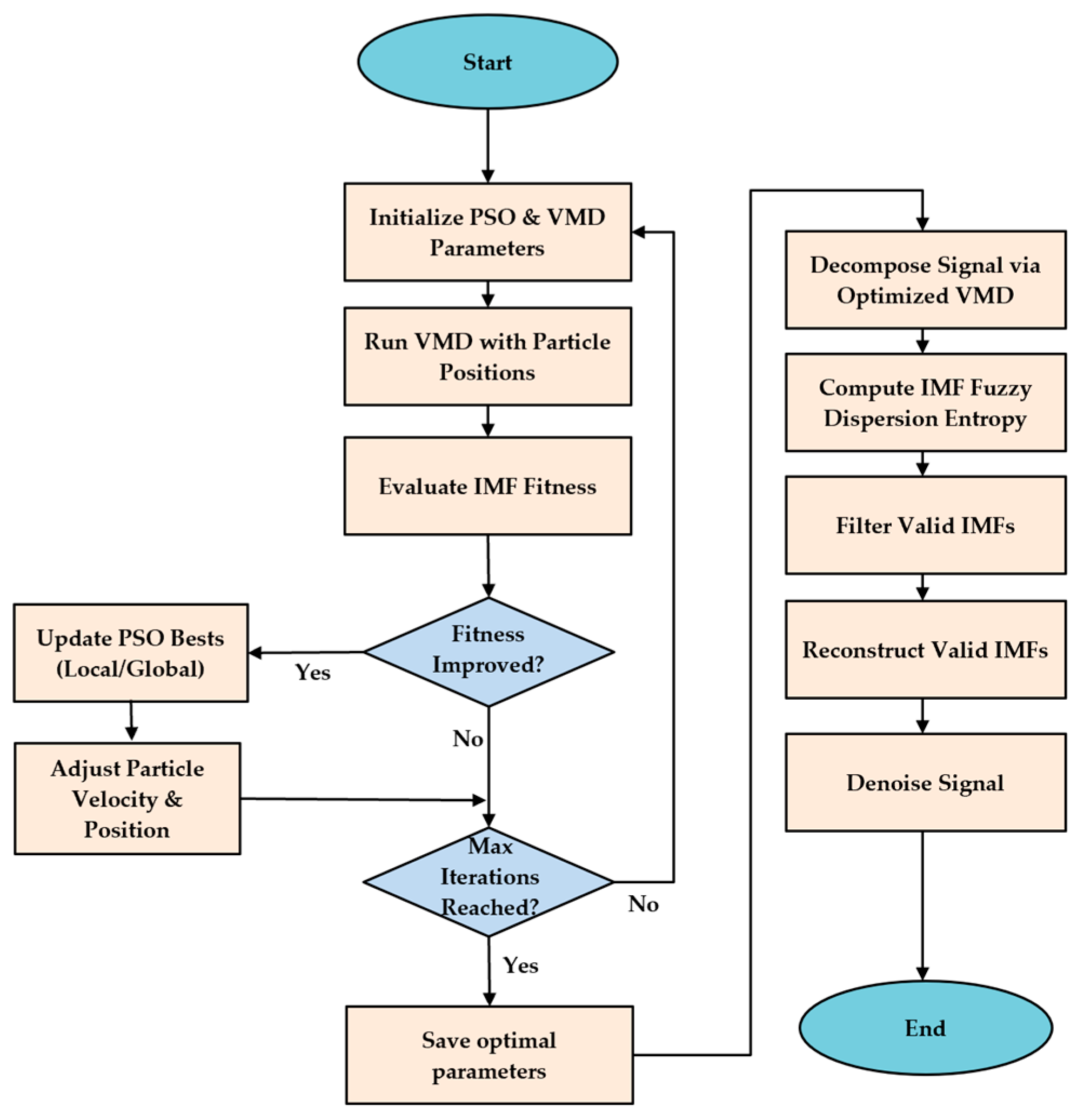
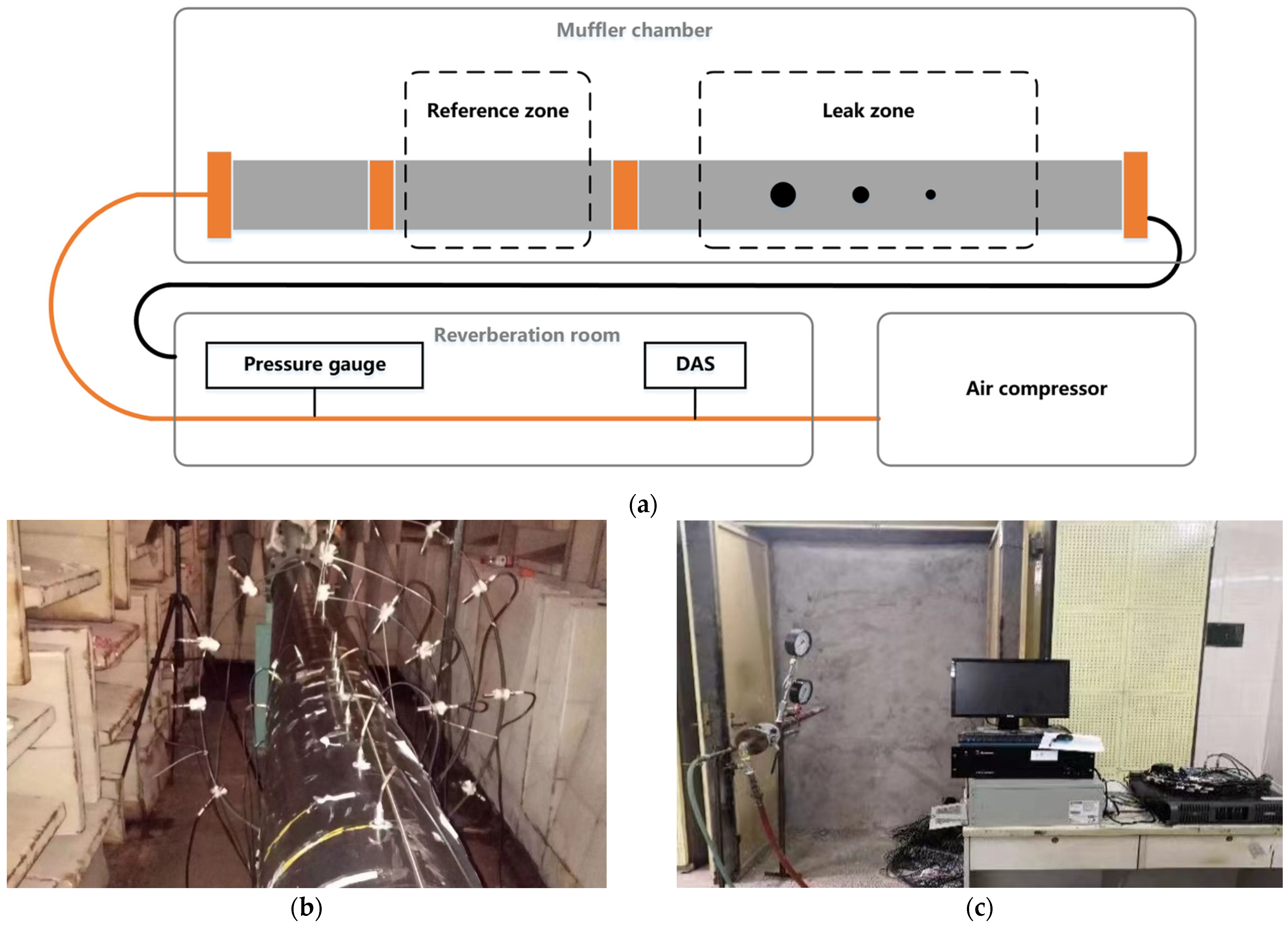
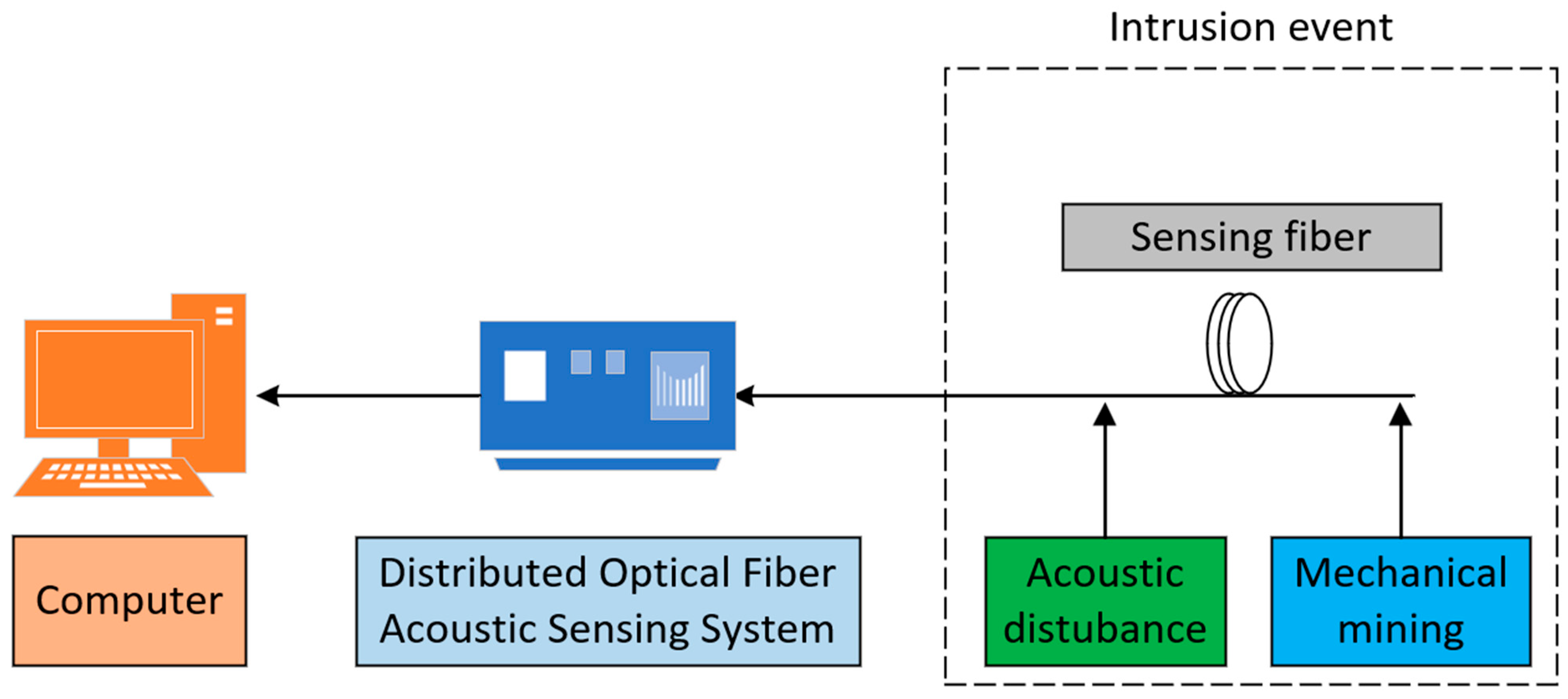
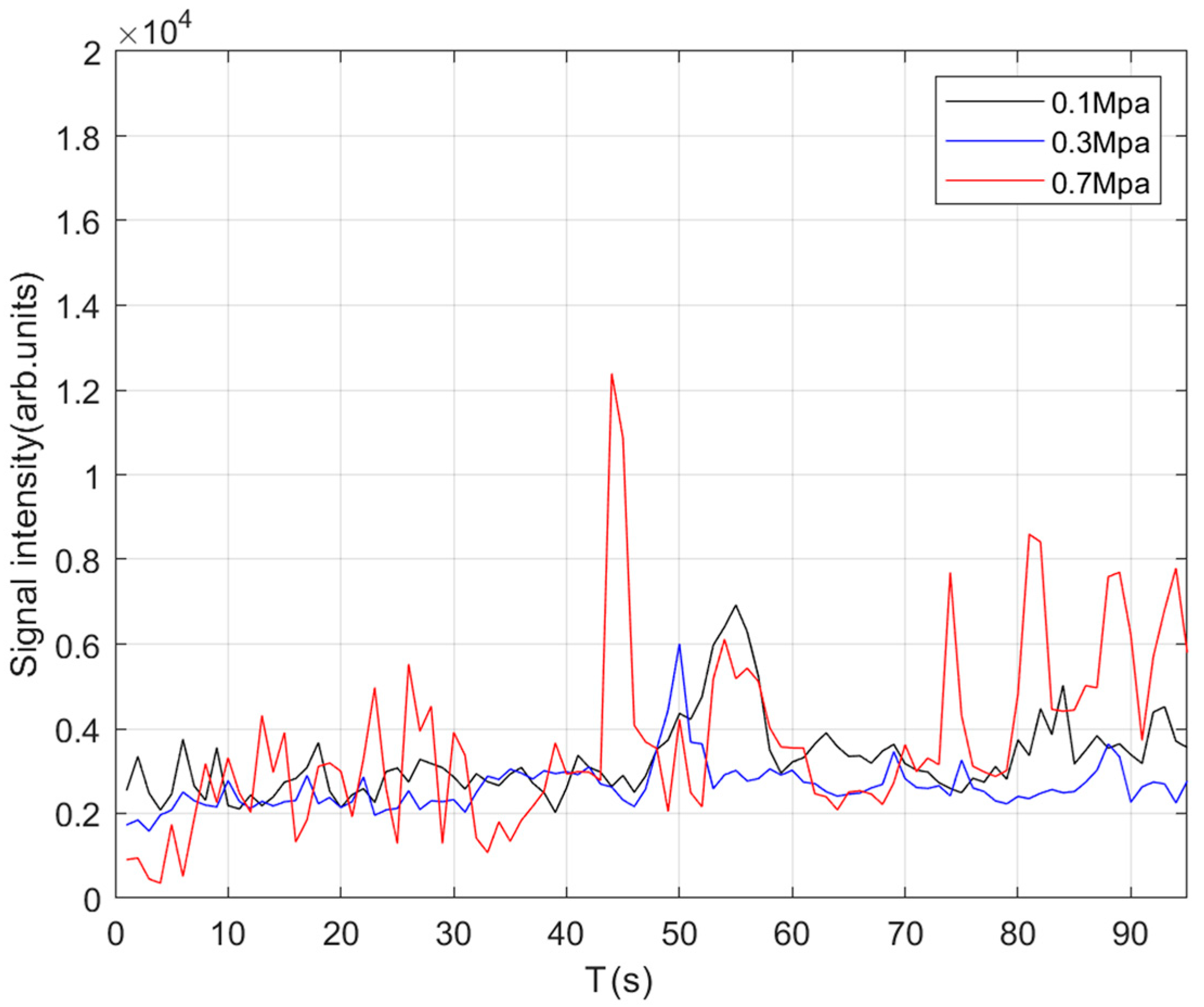
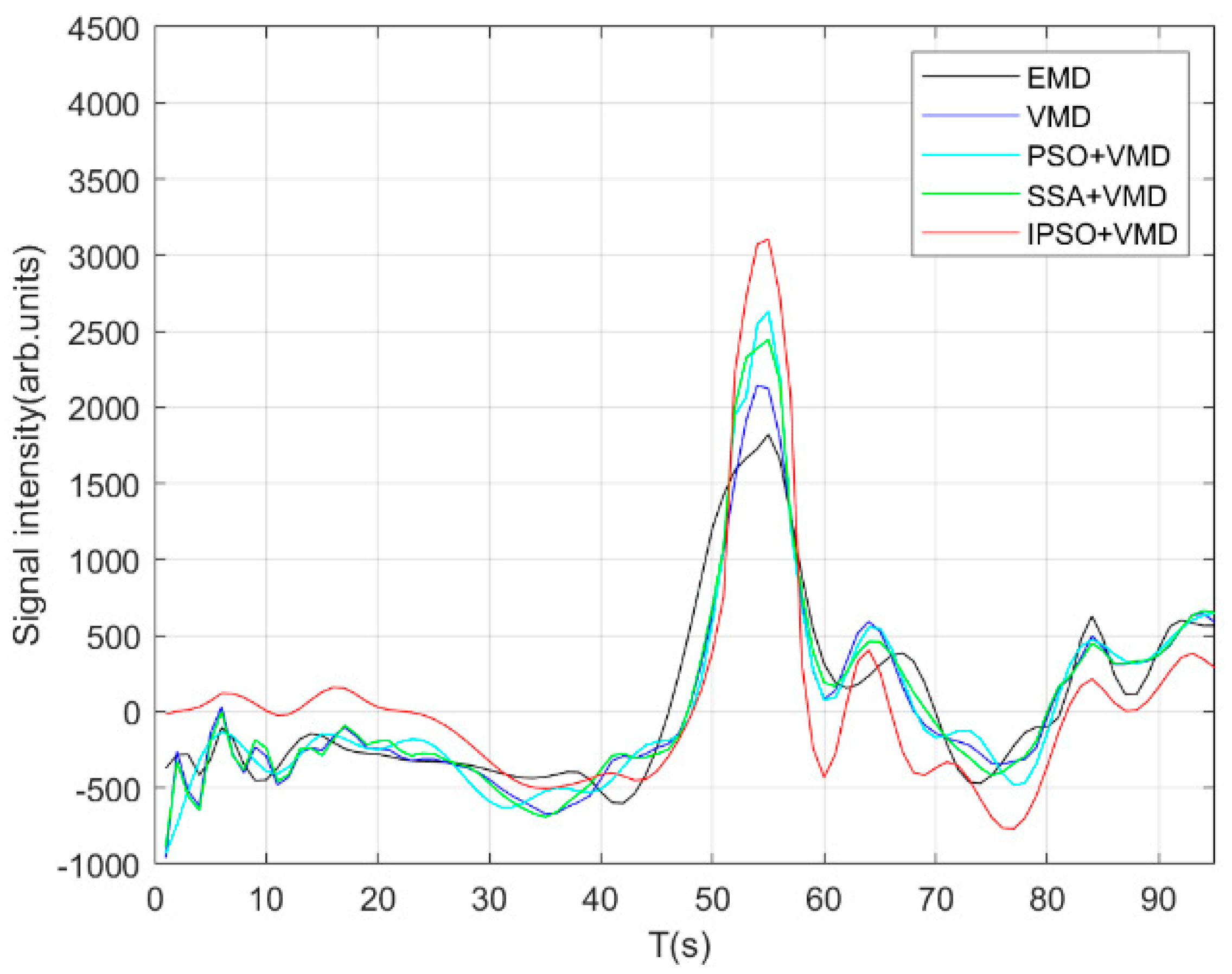
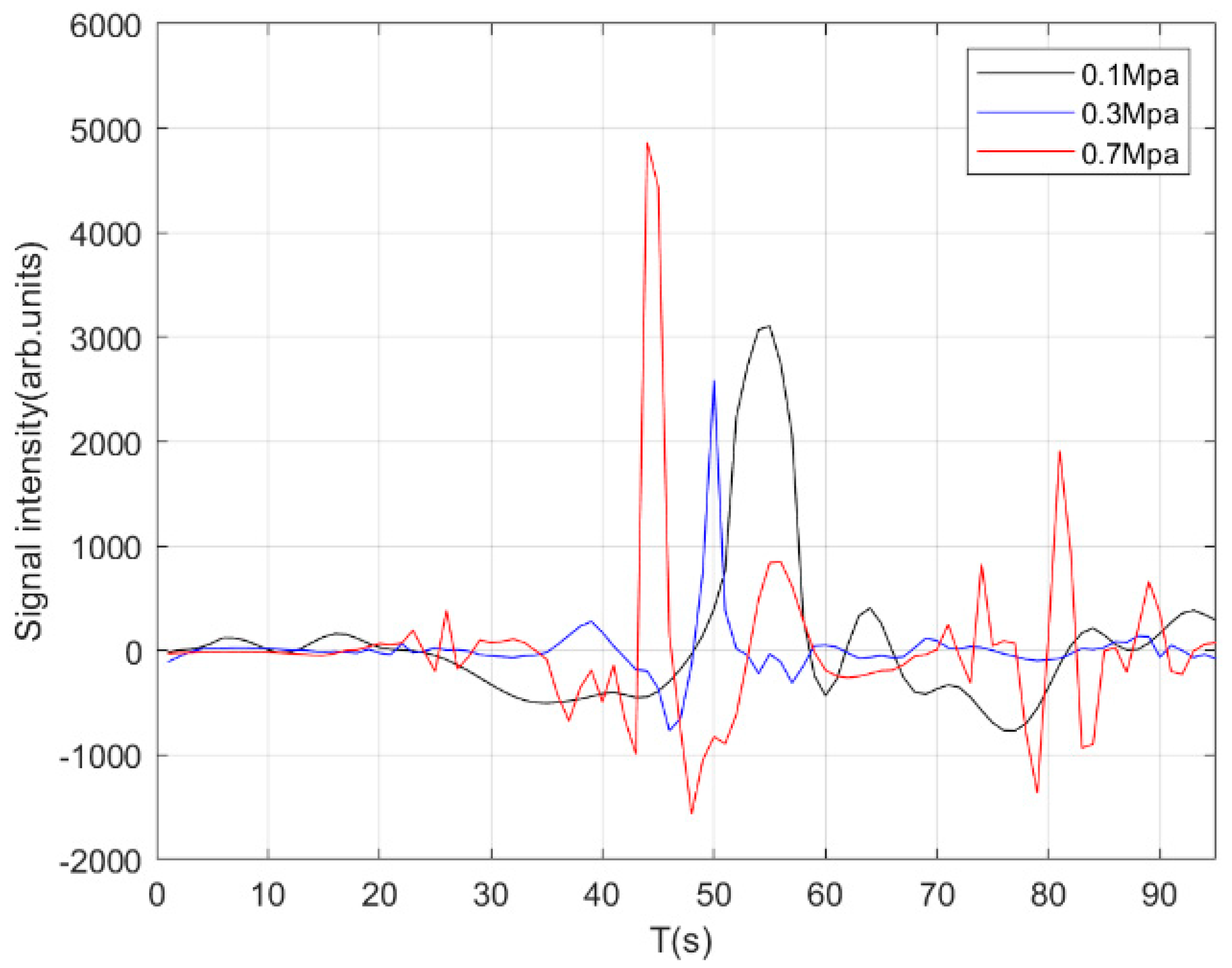
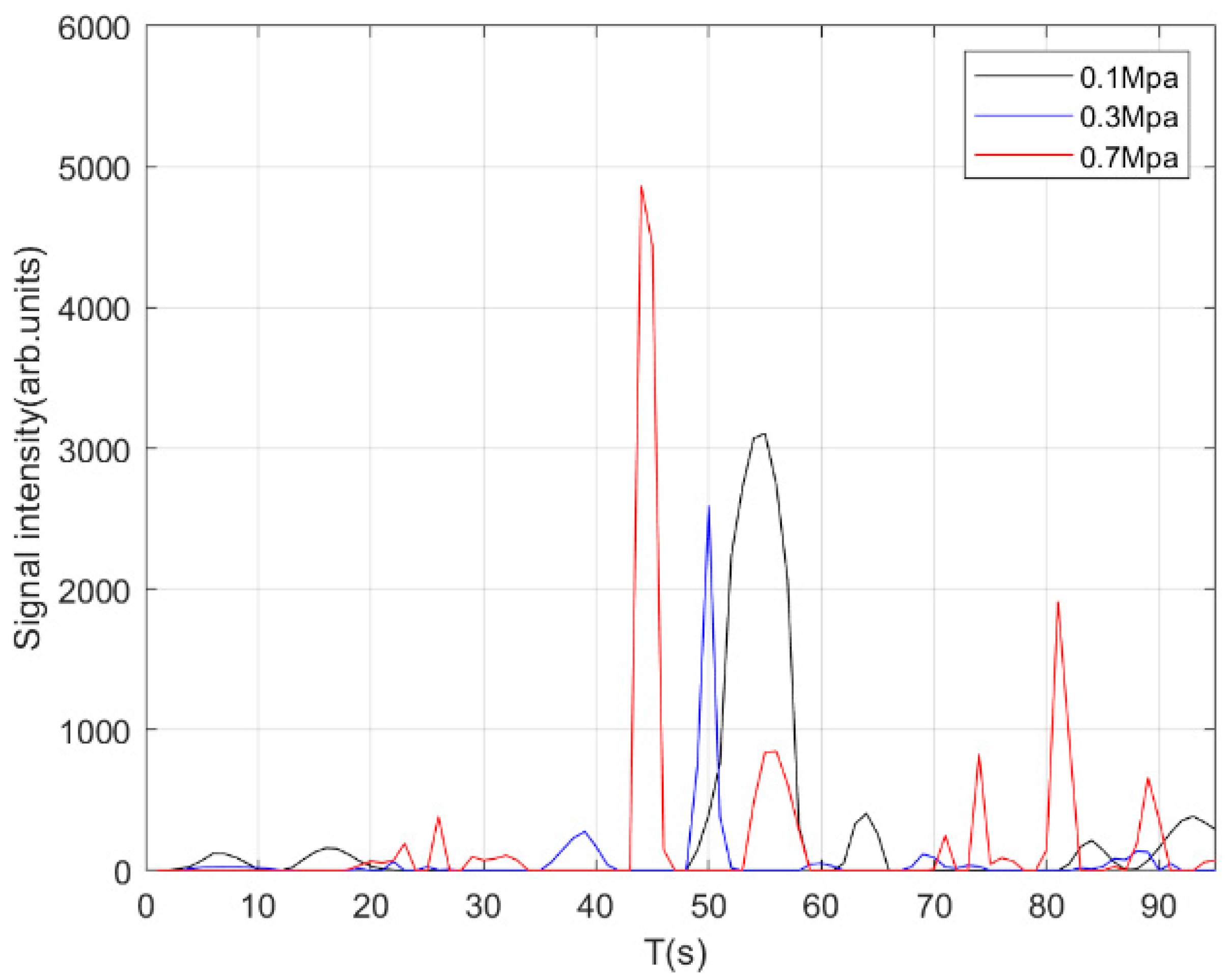
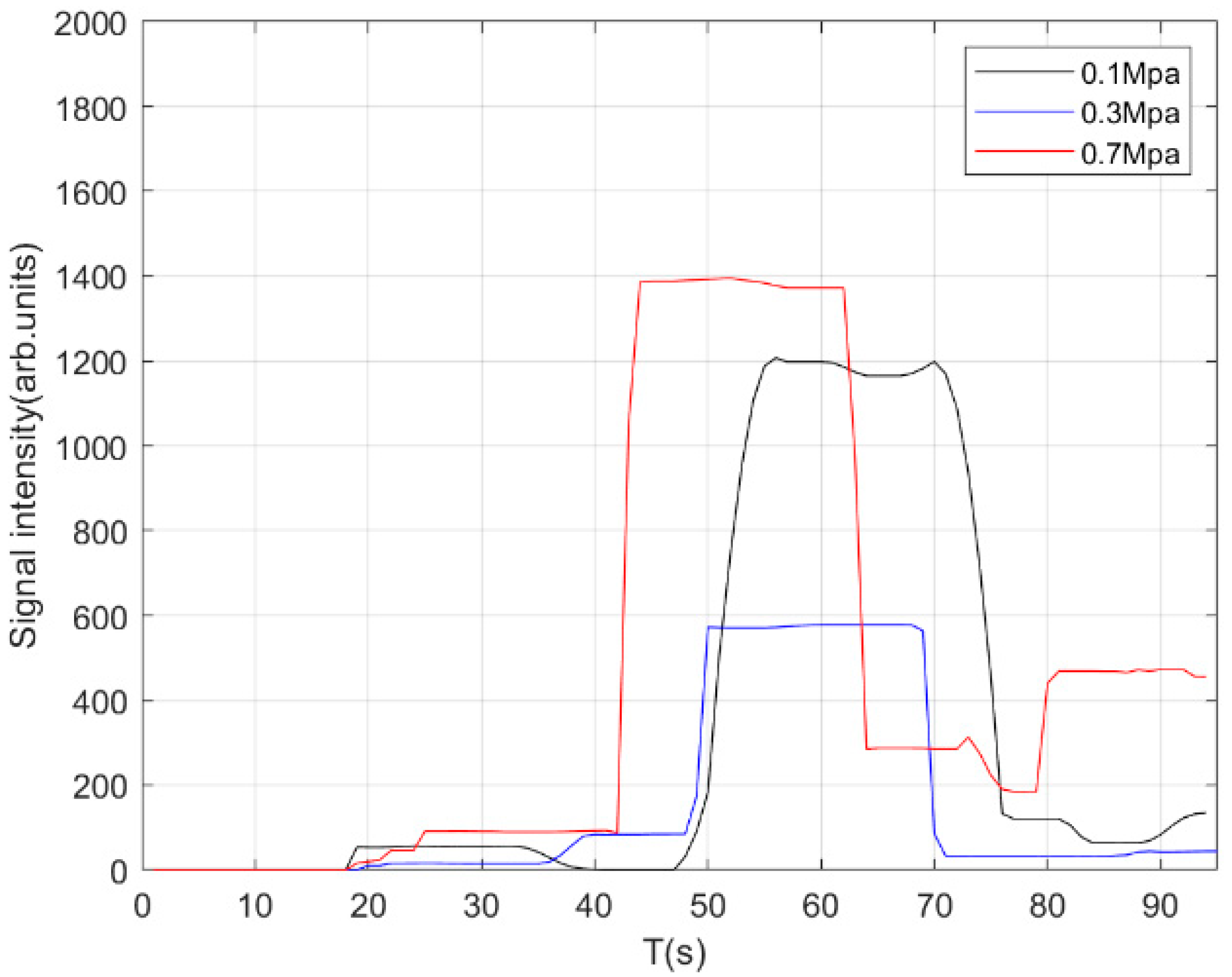
| Method | MSE | SNR (dB) |
|---|---|---|
| EMD | 0.0147 | 18.28 |
| VMD | 0.0097 | 19.96 |
| PSO + VMD | 0.0060 | 21.99 |
| SSA + VMD | 0.0068 | 21.38 |
| IPSO + VMD | 0.0027 | 24.15 |
Disclaimer/Publisher’s Note: The statements, opinions and data contained in all publications are solely those of the individual author(s) and contributor(s) and not of MDPI and/or the editor(s). MDPI and/or the editor(s) disclaim responsibility for any injury to people or property resulting from any ideas, methods, instructions or products referred to in the content. |
© 2025 by the authors. Licensee MDPI, Basel, Switzerland. This article is an open access article distributed under the terms and conditions of the Creative Commons Attribution (CC BY) license (https://creativecommons.org/licenses/by/4.0/).
Share and Cite
Xu, H.; Zuo, J.; Wang, T. Improved Variational Mode Decomposition in Pipeline Leakage Detection at the Oil Gas Chemical Terminals Based on Distributed Optical Fiber Acoustic Sensing System. J. Mar. Sci. Eng. 2025, 13, 531. https://doi.org/10.3390/jmse13030531
Xu H, Zuo J, Wang T. Improved Variational Mode Decomposition in Pipeline Leakage Detection at the Oil Gas Chemical Terminals Based on Distributed Optical Fiber Acoustic Sensing System. Journal of Marine Science and Engineering. 2025; 13(3):531. https://doi.org/10.3390/jmse13030531
Chicago/Turabian StyleXu, Hongxuan, Jiancun Zuo, and Teng Wang. 2025. "Improved Variational Mode Decomposition in Pipeline Leakage Detection at the Oil Gas Chemical Terminals Based on Distributed Optical Fiber Acoustic Sensing System" Journal of Marine Science and Engineering 13, no. 3: 531. https://doi.org/10.3390/jmse13030531
APA StyleXu, H., Zuo, J., & Wang, T. (2025). Improved Variational Mode Decomposition in Pipeline Leakage Detection at the Oil Gas Chemical Terminals Based on Distributed Optical Fiber Acoustic Sensing System. Journal of Marine Science and Engineering, 13(3), 531. https://doi.org/10.3390/jmse13030531







